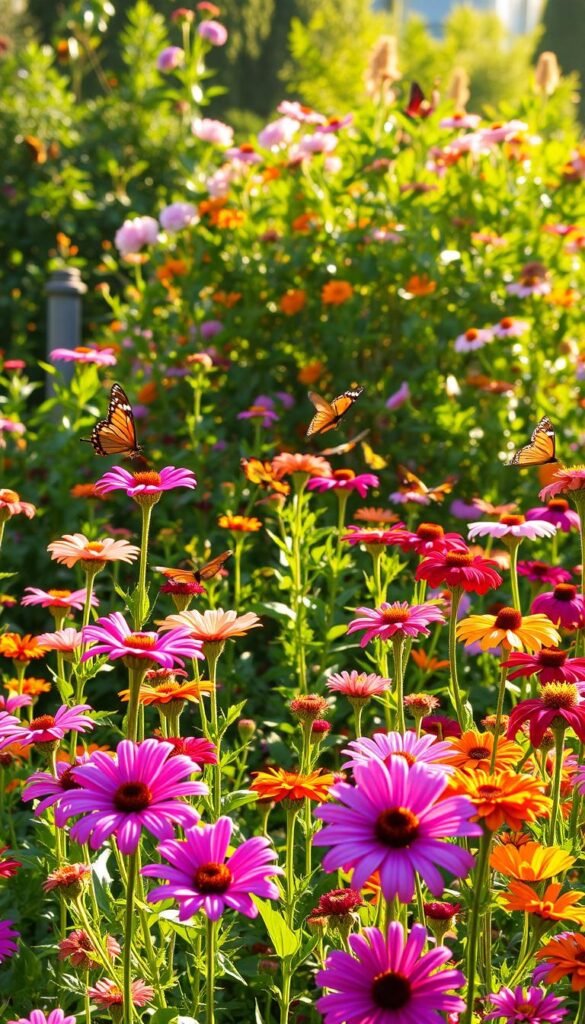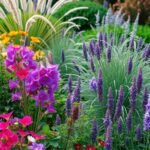Welcome to a world where vibrant blooms meet purposeful design. Transforming your outdoor area into a lively habitat doesn’t just brighten your surroundings—it supports essential wildlife while delivering year-round visual interest. This approach combines ecological responsibility with creative expression, offering rewards that extend far beyond surface beauty.
Thoughtful plant selection forms the foundation of these dynamic spaces. By focusing on native species through native plant gardening, you’ll nurture relationships between flora and fauna that evolved over centuries. These natural partnerships boost biodiversity while requiring less maintenance than non-native alternatives.
Strategic design elements turn functional habitats into living art. Clusters of nectar-rich blossoms in varying heights create movement and depth, while sheltered resting spots offer refuge. Staggering bloom times ensures a continuous buffet for winged visitors—from early spring emergers to late fall migrators.
You’ll discover how even compact areas can become thriving ecosystems. Whether working with acres or patio containers, our guide covers plant combinations, layout strategies, and care techniques. Prepare to craft a space where every element works in harmony—where beauty serves purpose and life flourishes at every turn.
Understanding the Beauty and Benefits of a Butterfly Garden

Creating a sanctuary for fluttering wings does more than dazzle the eye—it weaves life into your landscape. These spaces act as ecological bridges, offering shelter and nourishment to creatures facing shrinking wild habitats. Beyond their visual charm, they strengthen food systems by supporting species that pollinate crops like apples and tomatoes.
Nature’s Interconnected Web
Every plant plays a role in sustaining delicate life cycles. Monarchs rely solely on milkweed, while swallowtails seek parsley or dill. This specialization means your choices directly impact which butterfly species thrive. Even small patches of native flora create stepping stones between fragmented ecosystems.
Colors That Work Double Duty
Vivid blooms like coneflowers and zinnias aren’t just pretty—they’re landing pads for hungry visitors. Pairing purple, yellow, and red tones with varied heights mimics natural meadows. For compact spaces, try colorful container gardening to attract pollinators while maximizing vertical interest.
| Host Plant | Butterfly Species | Bloom Period |
|---|---|---|
| Milkweed | Monarch | Summer-Fall |
| Parsley | Black Swallowtail | Spring-Summer |
| Violet | Fritillary | Early Spring |
Studies show tending these habitats lowers stress hormones like cortisol. The act of nurturing growth—whether in sprawling yards or balcony pots—fosters mindfulness. You’re not just growing plants; you’re cultivating resilience for nature and yourself.
Planning and Designing Your Outdoor Space

Transform any corner into a thriving habitat by understanding your landscape’s unique potential. Successful designs balance practical needs with ecological purpose, turning ordinary areas into vibrant ecosystems.
Assessing Layout, Sunlight, and Space
Start by mapping your area’s dimensions and sun exposure. Most nectar plants crave 6-8 hours of direct light daily. Track shadows throughout the day using a sun calculator app or simple sketches.
| Space Feature | Ideal Conditions | Adaptation Tips |
|---|---|---|
| Sun Exposure | Full sun (south-facing) | Use reflective mulch |
| Soil Type | Well-draining loam | Add compost |
| Wind Patterns | Sheltered areas | Plant windbreaks |
Choosing Hardscapes and Pathways
Materials matter as much as plants. Crushed granite paths allow rainwater absorption, while flat stones create sunning spots for cold-blooded visitors. Curved walkways gently guide exploration without disrupting habitats.
“A meandering path invites discovery while protecting delicate roots and chrysalises.”
Blend functionality with beauty using these approaches:
- Position benches near flowering clusters for optimal viewing
- Install shallow water features with landing stones
- Use vertical structures like trellises to maximize small spaces
For design inspiration across various climates, explore pollinator garden styles that match your regional conditions. Remember to leave room for growth—both your plants’ and your evolving vision.
Butterfly Garden Aesthetic: Planting for Pollinators and Adding Colorful Accents

The secret to a flourishing habitat lies in pairing beauty with purpose. Your choices determine whether visitors simply pass through or establish multi-generational homes. Focus on two key elements: energy sources for adults and nurseries for future generations.
Fueling Flight with Floral Buffets
Adult fliers need quick energy from easy-access blooms. Evolution™ Colorific™ Coneflowers shine here, offering flat pink petals around bright green centers – perfect landing pads. These perennials pump out nectar-rich flowers from May through October, creating reliable pit stops.
Cluster three to five of the same plant type for visibility. Pair coneflowers with lantana’s clustered blooms and verbena’s spire-like flowers. This variety accommodates different feeding styles while keeping your space lively.
Building Butterfly Nurseries
Host plants work behind the scenes, sustaining caterpillars that become tomorrow’s pollinators. Milkweed reigns supreme, supporting monarchs from egg to chrysalis. Gay Butterflies Milkweed doubles as both nursery and nectar station with its fiery summer blooms.
Remember:
- Leave some leaf damage – it signals successful reproduction
- Plant host species in sheltered areas away from foot traffic
- Include regional natives like pawpaw trees for zebra swallowtails
For design inspiration across various regions, explore regional pollinator garden styles that align with your local ecosystem. Families can extend the learning experience through child-friendly pollinator projects, turning your yard into a living classroom.
Integrating Pollinator-Friendly Garden Elements

Creating a habitat that nurtures both pollinators and people requires thoughtful additions beyond plants. Focus on features that sustain beneficial insects while enhancing your enjoyment of the space.
Essential Hydration and Warmth Zones
Butterflies need shallow water sources for drinking and absorbing minerals. Try filling a clay saucer with sand and keeping it moist. Place flat stones in birdbaths to create safe perches.
Sun-drenched rocks or bare soil patches give cold-blooded visitors warmth. Position these spots near flowering clusters for quick energy boosts. Morning sunlight works best for activity peaks.
Human-Centered Design Touches
Comfortable seating lets you witness nature’s dramas unfold. A rustic bench near milkweed patches becomes front-row seating for caterpillar transformations. For elevating your outdoor space, add weather-resistant cushions in earthy tones.
Meandering paths of crushed shells or bark mulch guide exploration. Curve walkways around dense flower groupings to protect chrysalises. Wide enough for easy access, narrow enough to feel enveloped by blooms.
| Feature | Purpose | Maintenance Tip |
|---|---|---|
| Puddling Station | Mineral absorption | Refresh water daily |
| Basking Stones | Warmth regulation | South-facing placement |
| Observation Bench | Behavior monitoring | Clear sightlines to host plants |
Drawing Inspiration from Diverse Pollinator Garden Styles

Your outdoor space can become a living gallery showcasing nature’s artistry through intentional design choices. Three distinct approaches offer fresh perspectives for crafting environments that delight both people and winged visitors.
Embracing the Dreamy Cottage Vibe
This whimsical style blends chaos and charm, where blooms spill over pathways and wildlife thrives. Picture Pink Evolution™ Colorific™ Coneflowers dancing with feathery grasses, while lavender whispers through the breeze. For a deeper dive into this approach, explore our guide to the cottagecore aesthetic.
Exploring Dynamic Color Strategies
Two contrasting philosophies let you express your personality:
| Style | Color Palette | Key Plants | Atmosphere |
|---|---|---|---|
| Lively Layers | Pink + Purple + Orange | Zinnias, Marigolds, Sage | Energetic & Playful |
| Curated Color | Monochromatic Themes | Hydrangeas, Alliums, Roses | Sophisticated & Intentional |
The layered approach uses height variations to create depth. Tall sunflowers might backdrop mid-height cosmos, with creeping thyme carpeting the ground. Curated designs focus on repetition – imagine clusters of white phlox mirroring cloud shapes against emerald foliage.
Both styles prioritize plants that bloom from spring through fall. Incorporate milkweed for monarchs or fennel for swallowtails to maintain ecological function. Your garden becomes a stage where color choreography meets conservation.
Enhancing Your Garden with Bold and Colorful Accents
Color acts as nature’s invitation, drawing winged visitors while shaping your outdoor experience. Strategic combinations of fiery reds and calming blues create visual harmony that guides fliers to feeding zones. This approach balances ecological function with personal style, letting your space reflect both purpose and passion.
Crafting Nature’s Palette
Warm-toned plants like black-eyed Susans and blanket flowers radiate energy, while salvias and lavenders offer cooling contrast. Pair sunset-hued yarrow with violet catmint for striking combos that work across seasons. For those starting out, beginner-friendly blooms like zinnias provide instant impact with minimal effort.
Consider these elements when designing:
- Layer plants with staggered bloom times for continuous color
- Mix textures—feathery grasses beside bold coneflowers
- Include winter-interest species like red-twig dogwood
Your choices directly influence which species thrive. Red-hot poker plants attract hummingbirds, while milkweed sustains monarch caterpillars. By thoughtfully combining hues and habitats, you create living art that nourishes ecosystems and spirits alike.






